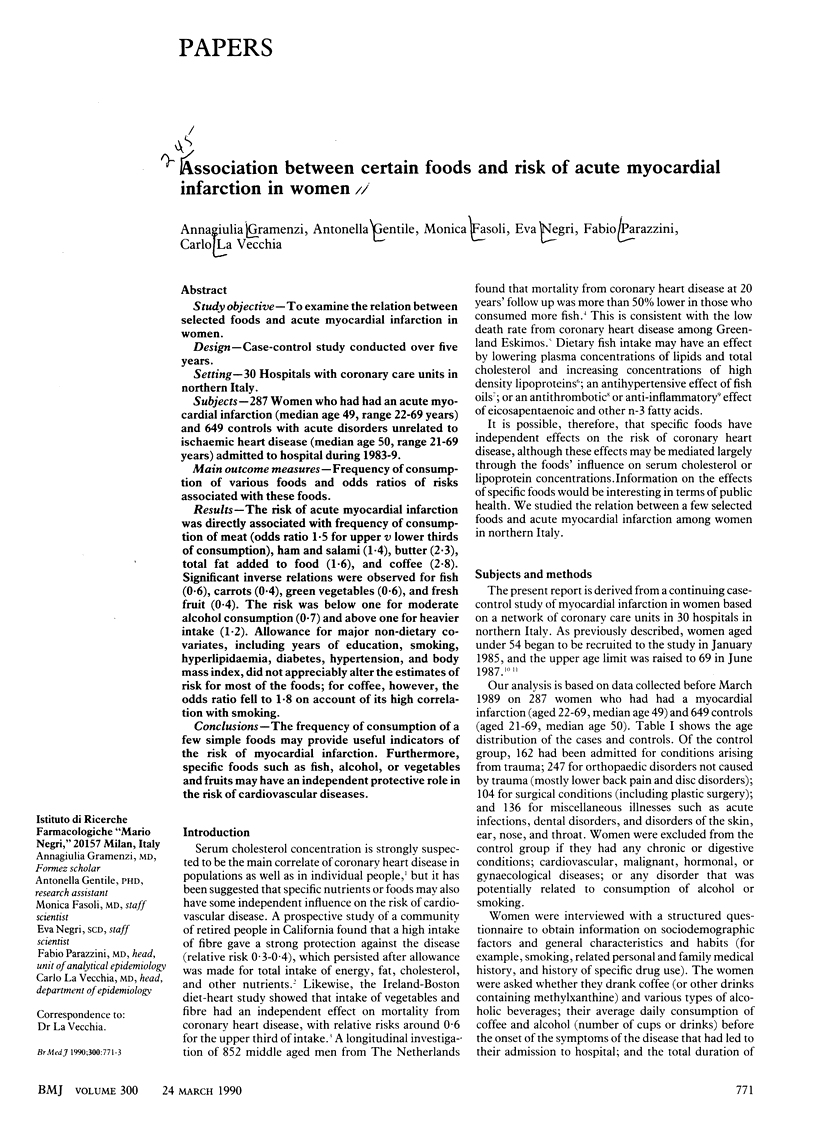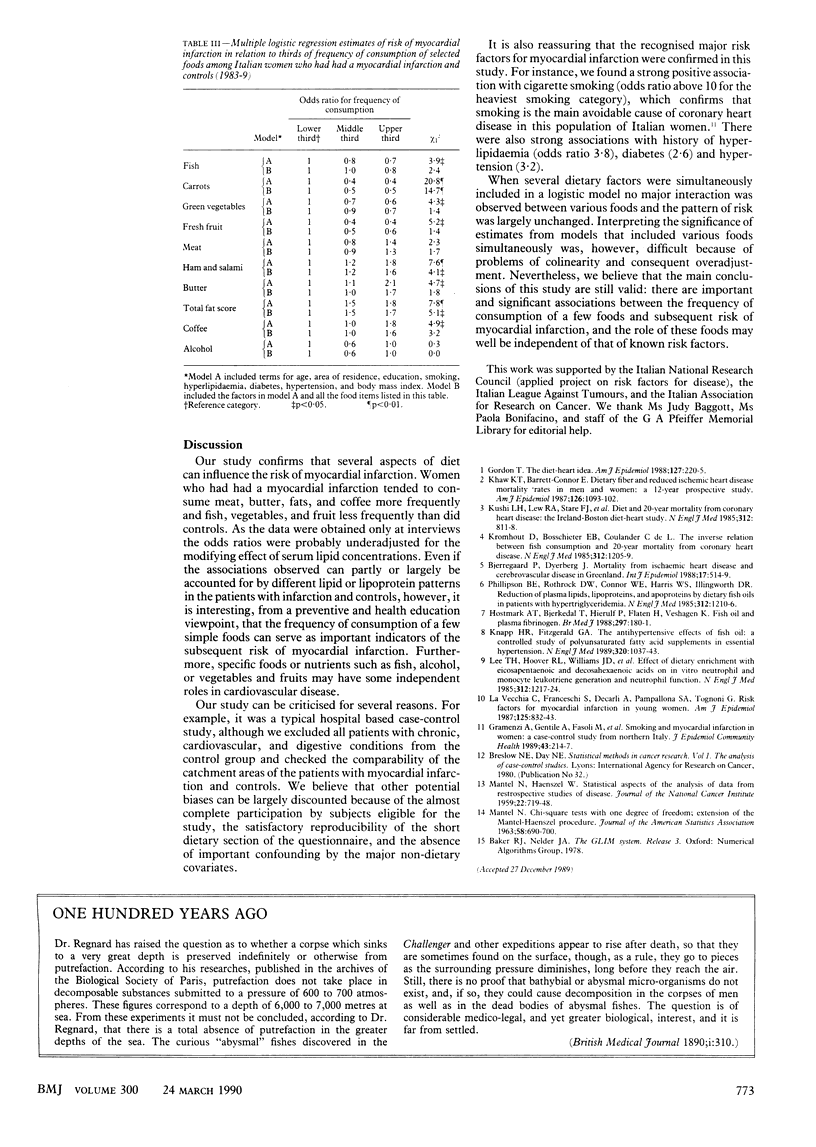Abstract
STUDY OBJECTIVE--To examine the relation between selected foods and acute myocardial infarction in women. DESIGN--Case-control study conducted over five years. SETTING--30 Hospitals with coronary care units in northern Italy. SUBJECTS--287 Women who had had an acute myocardial infarction (median age 49, range 22-69 years) and 649 controls with acute disorders unrelated to ischaemic heart disease (median age 50, range 21-69 years) admitted to hospital during 1983-9. MAIN OUTCOME MEASURES--Frequency of consumption of various foods and odds ratios of risks associated with these foods. RESULTS--The risk of acute myocardial infarction was directly associated with frequency of consumption of meat (odds ratio 1.5 for upper v lower thirds of consumption), ham and salami (1.4), butter (2.3), total fat added to food (1.6), and coffee (2.8). Significant inverse relations were observed for fish (0.6), carrots (0.4), green vegetables (0.6), and fresh fruit (0.4). The risk was below one for moderate alcohol consumption (0.7) and above one for heavier intake (1.2). Allowance for major non-dietary covariates, including years of education, smoking, hyperlipidaemia, diabetes, hypertension, and body mass index, did not appreciably alter the estimates of risk for most of the foods; for coffee, however, the odds ratio fell to 1.8 on account of its high correlation with smoking. CONCLUSIONS--The frequency of consumption of a few simple foods may provide useful indicators of the risk of myocardial infarction. Furthermore, specific foods such as fish, alcohol, or vegetables and fruits may have an independent protective role in the risk of cardiovascular diseases.
Full text
PDF


Selected References
These references are in PubMed. This may not be the complete list of references from this article.
- Bjerregaard P., Dyerberg J. Mortality from ischaemic heart disease and cerebrovascular disease in Greenland. Int J Epidemiol. 1988 Sep;17(3):514–519. doi: 10.1093/ije/17.3.514. [DOI] [PubMed] [Google Scholar]
- Gordon T. The diet-heart idea. Outline of a history. Am J Epidemiol. 1988 Feb;127(2):220–225. doi: 10.1093/oxfordjournals.aje.a114798. [DOI] [PubMed] [Google Scholar]
- Gramenzi A., Gentile A., Fasoli M., D'Avanzo B., Negri E., Parazzini F., La Vecchia C. Smoking and myocardial infarction in women: a case-control study from northern Italy. J Epidemiol Community Health. 1989 Sep;43(3):214–217. doi: 10.1136/jech.43.3.214. [DOI] [PMC free article] [PubMed] [Google Scholar]
- Høstmark A. T., Bjerkedal T., Kierulf P., Flaten H., Ulshagen K. Fish oil and plasma fibrinogen. BMJ. 1988 Jul 16;297(6642):180–181. doi: 10.1136/bmj.297.6642.180. [DOI] [PMC free article] [PubMed] [Google Scholar]
- Khaw K. T., Barrett-Connor E. Dietary fiber and reduced ischemic heart disease mortality rates in men and women: a 12-year prospective study. Am J Epidemiol. 1987 Dec;126(6):1093–1102. doi: 10.1093/oxfordjournals.aje.a114748. [DOI] [PubMed] [Google Scholar]
- Knapp H. R., FitzGerald G. A. The antihypertensive effects of fish oil. A controlled study of polyunsaturated fatty acid supplements in essential hypertension. N Engl J Med. 1989 Apr 20;320(16):1037–1043. doi: 10.1056/NEJM198904203201603. [DOI] [PubMed] [Google Scholar]
- Kromhout D., Bosschieter E. B., de Lezenne Coulander C. The inverse relation between fish consumption and 20-year mortality from coronary heart disease. N Engl J Med. 1985 May 9;312(19):1205–1209. doi: 10.1056/NEJM198505093121901. [DOI] [PubMed] [Google Scholar]
- Kushi L. H., Lew R. A., Stare F. J., Ellison C. R., el Lozy M., Bourke G., Daly L., Graham I., Hickey N., Mulcahy R. Diet and 20-year mortality from coronary heart disease. The Ireland-Boston Diet-Heart Study. N Engl J Med. 1985 Mar 28;312(13):811–818. doi: 10.1056/NEJM198503283121302. [DOI] [PubMed] [Google Scholar]
- La Vecchia C., Franceschi S., Decarli A., Pampallona S., Tognoni G. Risk factors for myocardial infarction in young women. Am J Epidemiol. 1987 May;125(5):832–843. doi: 10.1093/oxfordjournals.aje.a114599. [DOI] [PubMed] [Google Scholar]
- Lee T. H., Hoover R. L., Williams J. D., Sperling R. I., Ravalese J., 3rd, Spur B. W., Robinson D. R., Corey E. J., Lewis R. A., Austen K. F. Effect of dietary enrichment with eicosapentaenoic and docosahexaenoic acids on in vitro neutrophil and monocyte leukotriene generation and neutrophil function. N Engl J Med. 1985 May 9;312(19):1217–1224. doi: 10.1056/NEJM198505093121903. [DOI] [PubMed] [Google Scholar]
- Phillipson B. E., Rothrock D. W., Connor W. E., Harris W. S., Illingworth D. R. Reduction of plasma lipids, lipoproteins, and apoproteins by dietary fish oils in patients with hypertriglyceridemia. N Engl J Med. 1985 May 9;312(19):1210–1216. doi: 10.1056/NEJM198505093121902. [DOI] [PubMed] [Google Scholar]


